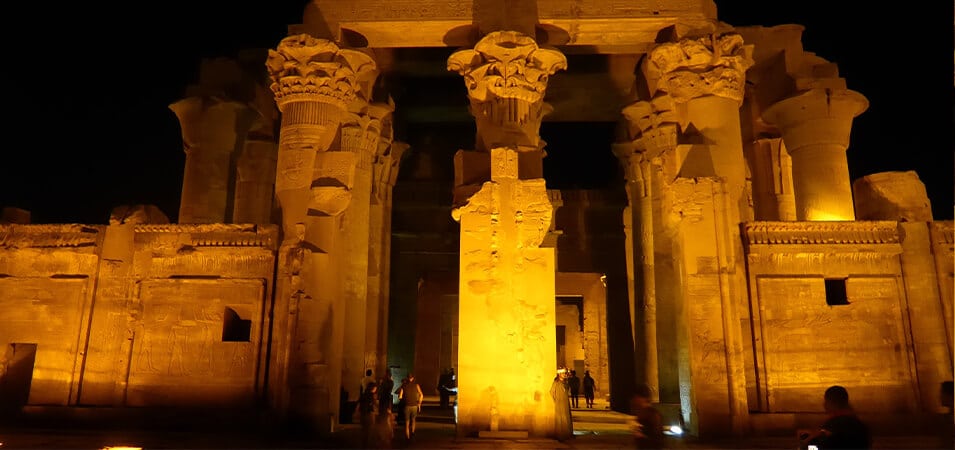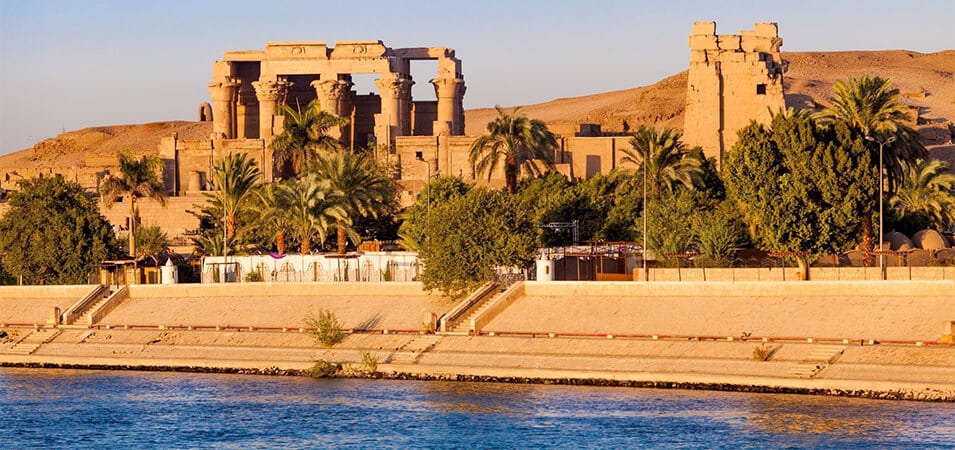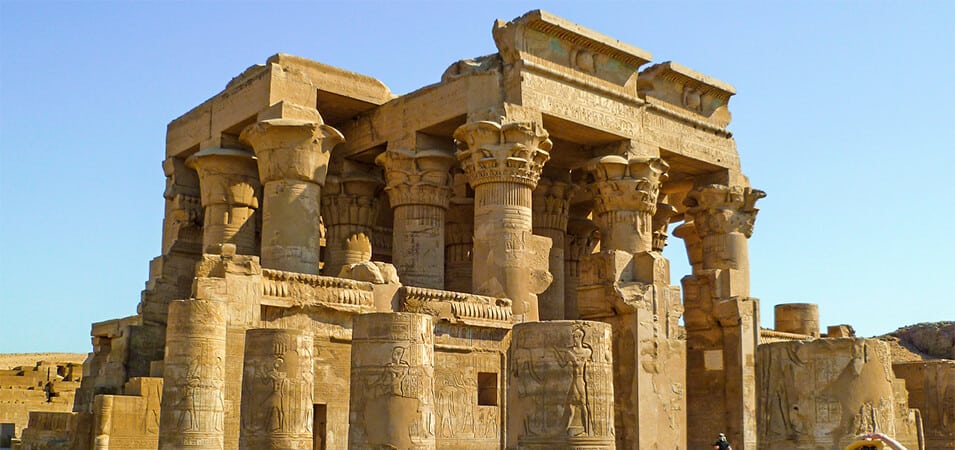The Kom Ombo Temple in Egypt, also called the “Temple of Sobek and Horus,” is a double temple built for two ancient Egyptian gods: Sobek, who had the head of a snake, and Horus, who had the head of a falcon. This temple is in the Aswan Governorate, on the banks of the Nile River. It shows how skilled and creative ancient Egyptian builders and architects were. Kom Ombo Temple is a collection of ancient Egyptian temples that is impressive and important to Egypt’s history and culture. Many people worldwide come to see this fantastic building because of its unique architecture and exciting history. In this piece, we’ll look at what’s so interesting about this Temple, including its rich history, architectural marvels, and the stories surrounding it. Join us as we go back in time to figure out the secrets and wonders of this beautiful temple.
Don’t Miss checking out our Egypt Tour Packages.
Historical background of Kom Ombo Temple

The history of it goes back to the time of the Ptolemies, which was around the 2nd century BC. But the site itself has a much longer past. There are signs of buildings from the time of the New Kingdom. Over the years, different rulers made changes and added to the temple complex, showing how their contributions changed. The Ptolemaic pharaohs, who were in charge of Egypt when the temple was built, wanted to honor and please the gods Sobek and Horus with this beautiful building. Today, It is a great example of how the ancient Egyptians practiced religion and how good they were at building.
The architecture and design
The design of the Kom Ombo Temple is based on traditional Egyptian temples, known for their large size and many small features. The temple complex comprises two parts of the same size and shape, each dedicated to a different god. The Kom Ombo Temple’s structure is symmetrical, making it stand out from other old Egyptian temples. The layout has grand approach gates, large courtyards, and a hall with intricately carved columns. The temple walls are decorated with hieroglyphic writing and symbolic reliefs that show religious rites and mythological scenes. The ancient Egyptians were very creative and skilled builders; this Temple is a great example of their work. Visitors are amazed by the accuracy and beauty of their buildings.
The Dual Nature of Kom Ombo Temple
The fact that Kom Ombo Temple has two sides is one of the most exciting things about it. The temple is split into two parts of the same size and shape. Each area has its entrance and sanctuaries for the gods Sobek and Horus. Sobek, the god with the head of a crocodile, stands for fertility and safety, while Horus, the god with the head of a falcon, stands for power and kingship. This unique building feature shows how different these two gods are and what they represent. When people go to Kom Ombo Temple, they can see the various sanctuaries and learn about the religious practices and beliefs of Sobek and Horus. This gives them a better understanding of the ancient Egyptians’ complex religious outlook.
The Hypostyle Hall and its Splendor
The stunning hypostyle hall, a true architectural masterpiece, welcomes people as they enter. The entrance is known for its tall columns with elaborate carvings and hieroglyphs. The astronomical pictures on the roof of the hypostyle hall show how interested the ancient Egyptians were in the sky. The hall’s size and grandeur make people feel like they’ve returned to an age of religious ceremonies and rituals. The hypostyle hall at Kom Ombo Temple is a great example of how creative and talented the ancient Egyptians were in building and art. This large hall was a place where religious events and rituals took place.
The Sacred Crocodile of Kom Ombo
In the area around Kom Ombo Temple, the Nile crocodile was considered holy in the past. The temple was home to a sacred crocodile that people thought was the god Sobek on earth. The temple priests respected and cared for the crocodile because they thought it was a living god. Crocodiles mummified and found in the temple complex show that the ancient Egyptians respected these animals. The sacred crocodile at Kom Ombo Temple shows how religious beliefs and respect for nature were tied together in ancient Egyptian society.

Religious Practices and Beliefs
The Kom Ombo Temple was important for religious rites and healing ceremonies. The temple’s monks were known for their knowledge and skill in medicine. On the temple walls are carvings of surgical tools and medical processes. This shows that the temple is a place of healing.
Mythological Significance of Kom Ombo Temple
The Kom Ombo Temple is a very important place in ancient Egyptian mythology. The story goes that Horus, the god with the head of a falcon, went to the temple to get back at his uncle Seth for killing his father, Osiris. Inscriptions and reliefs on the temple show this story from Egyptian mythology. This shows the ancient Egyptians believed in a battle between good and evil, order and chaos. At Kom Ombo Temple, the story of Horus and Seth shows how people have always fought for justice and the right to be king. When looking around the temple, people can get caught up in these fascinating old Egyptian myths.
The Medicinal Aspects of the Temple
The link between Kom Ombo Temple and ancient Egyptian medicine is fascinating. On the temple walls are pictures of different medical tools and surgical processes, which suggests that the priests here were very important in healing the sick and hurt. People think that in the past, doctors-to-be learned how to practice medicine at Kom Ombo.
Symbolism and Inscriptions
The walls and columns of Kom Ombo Temple are covered with complex hieroglyphic writing and pictures of symbols, making for a rich tapestry of meaning and symbolism. The hieroglyphs tell stories about old religious customs, rituals, and myths. The temple contains symbols like the ankh, the eye of Horus, and the lotus flower, which stand for life, protection, and rebirth. These writings tell us much about ancient Egyptians’ beliefs and how they treated their gods. By figuring out the meaning of the symbols and reading the detailed inscriptions, tourists can see how skilled ancient Egyptian scribes were, find out the hidden messages, and get a feel for the spiritual world of ancient Egypt.
Exploring Kom Ombo Temple Today
Today, people can visit Kom Ombo Temple to see its wonders and learn about its exciting past. The temple complex gives tourists a look into the rich tapestry of ancient Egyptian culture. They can see the fantastic architecture and spiritual beliefs of that time.
How to Reach Kom Ombo Temple
To get there, people can fly to Aswan International Airport, the closest airport to Kom Ombo Temple. You can quickly get to the temple complex by road or water. Some ways to get around the area, like taxis or guided walks, make the trip easy and fun.

Conclusion
The Kom Ombo Temple is a great example of how grand and advanced the ancient Egyptians were. Its unusual architecture, long history, and religious importance make it a must-see place for history buffs and curious tourists. By looking at the intricate carvings, figuring out what the hieroglyphs say, and learning about the legends, tourists can get lost in the mystery of this significant ancient Egyptian landmark and learn more about the culture and beliefs that made ancient Egypt what it was.
Don’t Miss checking out our Related Article :
